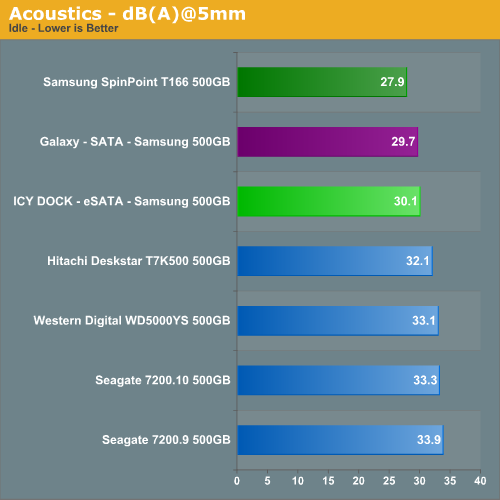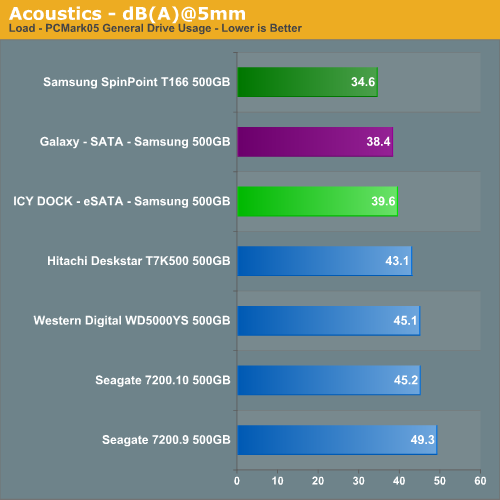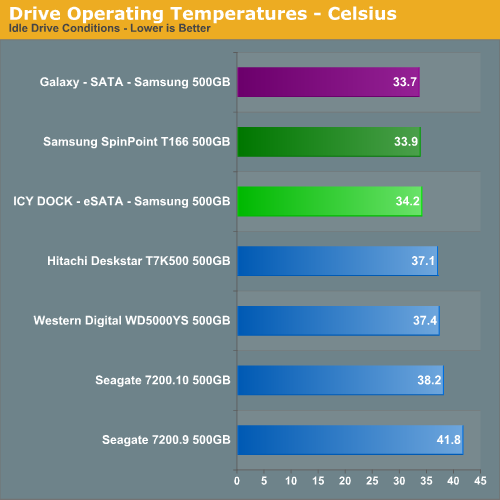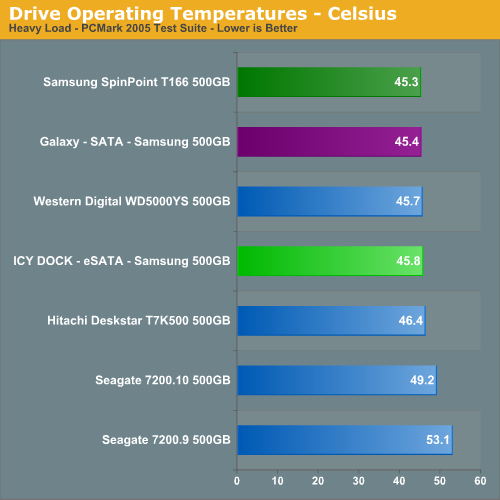Galaxy Metal Gear Box 3500SASP - SATA/USB 2.0 Enclosure on a Budget
by Gary Key on July 15, 2007 12:01 AM EST- Posted in
- Storage
Acoustics:
Our acoustic test utilizes our standard test bed components but we implement Intel's power saving technology and turn off the case fans to isolate as much case noise as possible during testing. Our Corsair power supply is nearly silent in these tests and our MSI 8800GTX video card is water cooled by an external unit to provide a further decrease in our case's ambient noise levels. Our drives are attached to the drive cage with rubber bushings to assist in isolating the noise of the drive and avoid the resulting harmonic changes due to the case design.
Our acoustic tests are designed to measure the decibel levels while the system is at idle and also under load while running the General Hard Disk Drive Usage benchmark within PCMark 2005. We found through trial and error that this particular benchmark produces controlled readings across a wide range of applications within the benchmark. This particular benchmark utilizes 60% reads and 40% writes within the trace playback file.
The measurements are taken at a distance of 5mm from the rear and front of the drive being tested in order to minimize surrounding environmental noise. We have noticed that unless we run a completely silent system in a quiet room that measurements taken from 1m are generally not meaningful due to ambient noise levels. There are exceptions to this rule, but overall most modern desktop drives are quieter now than the other components in the system while under load.
The reported measurements are based on an A-weighted decibel score that measures frequencies similar to the way the human ear responds to sound. We take a total of three measurements for each test. We then subtract the high and low scores and arrive at our findings by reporting the remaining score. Our base dB(A) level in the room at the time of testing was 25 dB(A).


Our Samsung SpinPoint T166 is a very quiet drive at idle but this drive likes to vibrate at times. Like the ICY DOCK, our Galaxy Metal Gear Box is not equipped with an internal damping system or acoustic padding, so its noise characteristics are different than our test case. The Galaxy drive enclosure amplified any drive noise that was already present with the Samsung unit. At idle, we noticed the Galaxy unit had less case vibration than the ICY DOCK that lead to a slightly lower noise floor result although subjectively they sounded the same.
Although our measurable test differences were substantial during load testing with both enclosures, it was quite difficult to pinpoint the differences in sound from a subjective viewpoint. During load testing seek operations were muted to some degree but were still booming if not sharp at times in both enclosures. However, we noticed the all aluminum Galaxy housing had less drive vibration under load than the plastic/aluminum combination of the ICY DOCK unit resulting in slight better noise control.
Like our ICY DOCK enclosure, the Galaxy unit would vibrate, especially when mounted horizontally, but the vibration induced hum was greatly reduced with the unit in a vertical position. A small amount of vibration noise was still noticeable in this position but was less than than a bare drive mount in our test case.
Thermals:
Our thermal tests utilize sensor readings via the S.M.A.R.T. (Self-Monitoring, Analysis and Reporting Technology) capability of the drives and are reported by utilizing the Active SMART 2.51 utility. We also utilize thermal sensors and infrared measurement devices to verify our utility results. We test our drives in an enclosed case environment without the fans operational to simulate temperatures that could conceivably be reached in a near silent SFF or HTPC case design. We typically find the reported numbers drop anywhere from 18% to 25% on average with the case fans operational. Our base temperature level in the room at the time of testing was 25C.


Our Samsung's drive temperature remained almost the same in our external enclosures as it did in our test case (without fans turned on) indicating that the lack of airflow was not an issue with this particular drive. The Galaxy Metal Gear Box only consumes 1.9W of power at idle or under load which helps to contribute to the low thermal output increases we noticed during testing.
Our acoustic test utilizes our standard test bed components but we implement Intel's power saving technology and turn off the case fans to isolate as much case noise as possible during testing. Our Corsair power supply is nearly silent in these tests and our MSI 8800GTX video card is water cooled by an external unit to provide a further decrease in our case's ambient noise levels. Our drives are attached to the drive cage with rubber bushings to assist in isolating the noise of the drive and avoid the resulting harmonic changes due to the case design.
Our acoustic tests are designed to measure the decibel levels while the system is at idle and also under load while running the General Hard Disk Drive Usage benchmark within PCMark 2005. We found through trial and error that this particular benchmark produces controlled readings across a wide range of applications within the benchmark. This particular benchmark utilizes 60% reads and 40% writes within the trace playback file.
The measurements are taken at a distance of 5mm from the rear and front of the drive being tested in order to minimize surrounding environmental noise. We have noticed that unless we run a completely silent system in a quiet room that measurements taken from 1m are generally not meaningful due to ambient noise levels. There are exceptions to this rule, but overall most modern desktop drives are quieter now than the other components in the system while under load.
The reported measurements are based on an A-weighted decibel score that measures frequencies similar to the way the human ear responds to sound. We take a total of three measurements for each test. We then subtract the high and low scores and arrive at our findings by reporting the remaining score. Our base dB(A) level in the room at the time of testing was 25 dB(A).


Our Samsung SpinPoint T166 is a very quiet drive at idle but this drive likes to vibrate at times. Like the ICY DOCK, our Galaxy Metal Gear Box is not equipped with an internal damping system or acoustic padding, so its noise characteristics are different than our test case. The Galaxy drive enclosure amplified any drive noise that was already present with the Samsung unit. At idle, we noticed the Galaxy unit had less case vibration than the ICY DOCK that lead to a slightly lower noise floor result although subjectively they sounded the same.
Although our measurable test differences were substantial during load testing with both enclosures, it was quite difficult to pinpoint the differences in sound from a subjective viewpoint. During load testing seek operations were muted to some degree but were still booming if not sharp at times in both enclosures. However, we noticed the all aluminum Galaxy housing had less drive vibration under load than the plastic/aluminum combination of the ICY DOCK unit resulting in slight better noise control.
Like our ICY DOCK enclosure, the Galaxy unit would vibrate, especially when mounted horizontally, but the vibration induced hum was greatly reduced with the unit in a vertical position. A small amount of vibration noise was still noticeable in this position but was less than than a bare drive mount in our test case.
Thermals:
Our thermal tests utilize sensor readings via the S.M.A.R.T. (Self-Monitoring, Analysis and Reporting Technology) capability of the drives and are reported by utilizing the Active SMART 2.51 utility. We also utilize thermal sensors and infrared measurement devices to verify our utility results. We test our drives in an enclosed case environment without the fans operational to simulate temperatures that could conceivably be reached in a near silent SFF or HTPC case design. We typically find the reported numbers drop anywhere from 18% to 25% on average with the case fans operational. Our base temperature level in the room at the time of testing was 25C.


Our Samsung's drive temperature remained almost the same in our external enclosures as it did in our test case (without fans turned on) indicating that the lack of airflow was not an issue with this particular drive. The Galaxy Metal Gear Box only consumes 1.9W of power at idle or under load which helps to contribute to the low thermal output increases we noticed during testing.










7 Comments
View All Comments
takumsawsherman - Monday, July 16, 2007 - link
is how long this model lasts. I've had a couple of very similar looking Masscools die on me. There is a real lack of a reliable, metal enclosure, with a built in power supply, quiet fan, and a chipset that just works.Though initially disappointed with my PPA/Bytecc with the dreaded Prolific 3507 chipset, after a couple of firmware updates, it seems to be rock solid. ByteCC now sells a mostly metal 5 1/4 inch enclosure with Firewire daisy chain, USB2, and a built in power supply and fan. Still uses that Prolific chipset, but so far I have not had any issues.
The biggest disappointment for me is how many manufacturers seem to think that we want to carry AC-DC bricks around with us. Using an standard IEC cable means one less thing to remember.
AmberClad - Monday, July 16, 2007 - link
I've had an IDE version of this exact same model for the past three years and it's still working fine. The one I had was manufacturered by PPA though, not Masscool or GMG.This particular design (with the anodized aluminum body and Metal Gear Solid knock-off artwork) seems to have been around for quite a few years and it's built by various different companies (makes me wonder who was behind the original design). The SATA interface seems to be new though.
RamarC - Monday, July 16, 2007 - link
My metal gear box with ide drive and fw/usb ports has been running for over 2.5 years now. I've had no problems/issues since installing it.Slash3 - Sunday, July 15, 2007 - link
Has anyone from Konami seen these things yet? It's bad enough that they put "Metal Gear Box" on the side, in the Metal Gear Solid font, but then they go one further and add the Substance subscript. How Do they get away with it...Cheese Factor +10
AmberClad - Monday, July 16, 2007 - link
I'm not sure which is more blatant -- this, or SuperTalent's Walmart-inspired heatspreader artwork :-D.Souka - Monday, July 16, 2007 - link
They could've put another line under the logo....something like, "It's SOLID":)
mojotronic - Monday, September 7, 2009 - link
A solid POS.I bought one (a "Substance 2" model -- and I suspect the "substance" referred to is brown and smelly) with a 320 GB Seagate drive and the defective circuitry of the enclosure fried the HD. It worked for about a week when I got it, then one day the blue led light on the bottom flickered erratically and the HD icon disappeared from my desktop. I removed the drive and tested it in my tower and it was dead. As in killed.
I subsequently tried an old but working 20GB drive in the Metal Gear Box just to confirm that it was the enclosure at fault. The drive mounted. My computer froze. The drive icon disappeared. Upon restarting the drive icon was gone. The drive was dead.
I will now take a hammer to the nice-looking but ravenous enclosure. I wouldn't trust a replacement, and will never buy another product from Galaxy again.